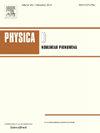具有不对称动量分布的哈密顿蒙特卡罗
IF 2.9
3区 数学
Q1 MATHEMATICS, APPLIED
引用次数: 0
摘要
现有的Hamiltonian Monte Carlo (HMC)算法的严格收敛保证使用高斯辅助动量变量,这些辅助动量变量是关键对称分布的。利用新的动力学和概率参数,提出了一种新的HMC收敛分析方法。在较弱的条件下严格地建立了收敛性,其中包括一般辅助分布。在我们的框架中,我们证明了具有不对称动量分布的普通HMC打破了一个关键的自伴随性要求。我们提出了一种改进的HMC,我们称之为交替方向HMC (AD-HMC),它克服了这个困难。建立了AD-HMC在Wasserstein距离上呈现几何收敛的充分条件。将几何收敛分析推广到用跳越型辛积分器逼近哈密顿运动时,其中需要增加一个Metropolis-Hastings抑制步骤。数值实验表明,AD-HMC可以推广一种流行的动态辅助方案,以提高具有高斯辅助的HMC的性能。本文章由计算机程序翻译,如有差异,请以英文原文为准。
Hamiltonian Monte Carlo with asymmetrical momentum distributions
Existing rigorous convergence guarantees for the Hamiltonian Monte Carlo (HMC) algorithm use Gaussian auxiliary momentum variables, which are crucially symmetrically distributed. We present a novel convergence analysis for HMC utilizing new dynamical and probabilistic arguments. The convergence is rigorously established under significantly weaker conditions, which among others allow for general auxiliary distributions. In our framework, we show that plain HMC with asymmetrical momentum distributions breaks a key self-adjointness requirement. We propose a modified version of HMC, that we call the Alternating Direction HMC (AD-HMC), which overcomes this difficulty. Sufficient conditions are established under which AD-HMC exhibits geometric convergence in Wasserstein distance. The geometric convergence analysis is extended to when the Hamiltonian motion is approximated by the leapfrog symplectic integrator, where an additional Metropolis–Hastings rejection step is required. Numerical experiments suggest that AD-HMC can generalize a popular dynamic auxiliary scheme to show improved performance over HMC with Gaussian auxiliaries.
求助全文
通过发布文献求助,成功后即可免费获取论文全文。
去求助
来源期刊

Physica D: Nonlinear Phenomena
物理-物理:数学物理
CiteScore
7.30
自引率
7.50%
发文量
213
审稿时长
65 days
期刊介绍:
Physica D (Nonlinear Phenomena) publishes research and review articles reporting on experimental and theoretical works, techniques and ideas that advance the understanding of nonlinear phenomena. Topics encompass wave motion in physical, chemical and biological systems; physical or biological phenomena governed by nonlinear field equations, including hydrodynamics and turbulence; pattern formation and cooperative phenomena; instability, bifurcations, chaos, and space-time disorder; integrable/Hamiltonian systems; asymptotic analysis and, more generally, mathematical methods for nonlinear systems.
 求助内容:
求助内容: 应助结果提醒方式:
应助结果提醒方式:


